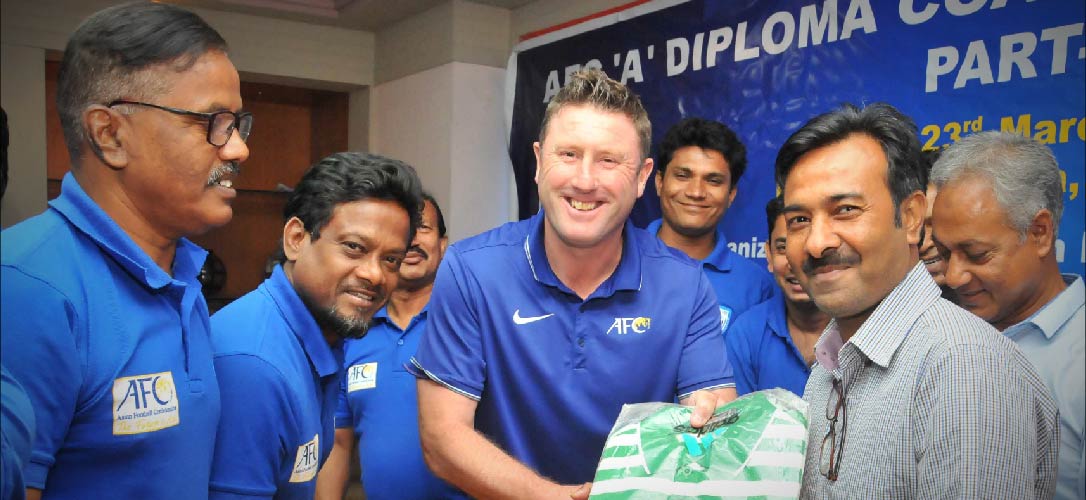By Syed Faiz Ahmed
When we put together the strategic plan for 2016 to 2020, we made a number of findings through the research, and then as part of the plan, we communicated what was necessary to improve the game and overcome one of the problems you might identify. For example, in order to make BCL (Bangladesh Champions League) and BPL (Bangladesh Premier League) professional leagues, one must help those kids to reach a technical, commercial, and financial level of professionalization. The strategy plotted a way to achieve this. So that’s one area. Another area was about improving football. In Bangladesh, the real challenge is very diverse. It is a largely populated country helped put home-zone football across the divisions, some of which delivered grassroots programs by working closely with BFF. Festivals, competitions and tournaments are now being organized in order to sustain development and promote new spirit. Another strategy was to help develop knowledge and training among the coaches that are working in Bangladesh and help them reach the standard across Asia and Europe. A variety of grassroots initiatives are taking place in every division, meaning eight home zones of football, will lead to more players, coaches, referees, volunteers, administrative management, journalists, and media. Following this, the best players, both male and female, can be identified and sent to residential academies. In residential academies, they are provided with proper training, food, and accommodation.
We pioneered a residential academy with the league’s female players. Now, we are working on bringing together players of all age groups so that the under-12 boys and under-16 boys and girls can associate with the under-19 and under-23 players that are registered with BCL and BPL groups. We have a detail strategy plan and we have sections in that plan for the business of football as FIFA wanted to understand those business strategies. Let me give you one example of the business strategy. There was a need to adopt more of the corporate structure here in the federation, so we have departments full of people here in the federation to have a more corporate culture.
Developing players, teams, and coaches of the highest level take time. The success has been very pragmatic. In 2017, outside some of the media articles that have been written, a lot of the things were actually moving forward nicely. Another part of the business strategies was to have a communication strategy on how to involve the media. So those people from the part of this discussion are part of the ongoing communication with the general public at home and abroad.
People that are working in the federation sometimes don’t understand or become confused. Therefore, BFF faces challenges regarding their own internal communications. There is also a challenge in their external communications. I’ve seen many journalists talking to people who don’t necessarily have the information regarding the strategic plan or know how to give a bit more perspective in the world of football globally.
I remember mentioning that the federation should invite the media into the BFF in 2016. The federation could then provide explanations, discourse, debate, and get feedback from the media. These relationships, in my opinion, are critical as journalists such as yourself have the power to portray things either with positivity or negativity.
I have been very proud of everything we have achieved in 12 months, but there is still a long way to go. So, it’s an ongoing process and we have big plans we came up with after FIFA and AFC informed us that we would not receive proper funding without it. If the federation is looking for some financial assistance as sponsors, businesses usually want presentations and glossy brochures. They want to know what the organization is going to do for them and how they can leverage that particular sponsor. That has been my responsibility here in the federation. In comparison with China, Korea, Japan, Australia, all of those organizations have major partners. Now the football plateau in those countries is very different from how it is in Bangladesh. Essentially, there are organizations that have major partners who have been with them for a long time. And I know those partners have asked for strategic plans. So we have a great opportunity here in Bangladesh. The economy is stronger than it has ever been. I think Bangladesh is 41st in the world in common economic perspective and it’s fantastic. So why can’t football find a place in the market? Countries like Singapore and India are going through the same process.
I think there is good money for the players here in Bangladesh. Whether it’s a good thing or not, there are clubs prepared to pay players, even foreign players, to come and play. My concern is to provide an opportunity for the younger players to play in professional leagues, and if those players show talent within the professional leagues here, then we must leverage the talent and acquire those players for our international team as quickly as possible and provide opportunities for them outside of Bangladesh in professional leagues. These players spend over a year together, and after commitment within the plan and the federation president, these players stay together for the next four years. Although taking longer than four years would be ideal in my opinion, this is still a good practice. It takes place in all the major countries like England, Australia, Japan, and China. We had to emulate what was happening around the world. There is an abundance of talented players here in Bangladesh. Unfortunately, they don’t always get the right opportunities at the right time. However, in order to capture all this potential, a strategic plan must be formulated.
The federation has been trying to put many astroturfs around the country. So in these eight divisions that I like to call the hubs of football, astroturfs should be built by the AFC. This leads to more people such as players, coaches, referees, volunteers, and administrators getting involved in the game. In Dhaka, there is only a national stadium with an astroturf in Kamlapur. If you look at capital cities around the world, the case is different. In Seoul, the capital of South Korea, there are football facilities like astroturfs, stadiums, and grass fields almost every hundred yards. In China, they are planning to put in 75,000 astroturfs over the next five years. It is especially difficult in Bangladesh because of the land crisis.
PEOPLE TEND TO SAY THAT THE PLAYERS FROM THIS PART OF THE WORLD ARE NOT PHYSICALLY BUILT TO PLAY FOOTBALL. WHAT DO YOU HAVE TO SAY ABOUT THAT?
As I mentioned before, there is an abundance of talent in Bangladesh. However, it is difficult to harness. Each player needs the right diet, lifestyle, environment, and training during their journey towards progress. Even the people with a lot of potential will not be able to succeed if they don’t follow a certain set of rules. We must grab this raw talent and provide the right training, food, and environment to them. Simply providing them with a perfectly balanced diet will lead to vast development.
AKHI’S STORY, THE TESTIMONIAL FOR PAUL’S WORDS
During the conversation with Paul Thomas Smalley, a talented young girl playing for the under-16 national team entered the room. Akhi was 4’1” when she started training in 2013, and within a couple of years she shot up to a 5’6” well-built girl. She was also the vice-captain of her team.
Hailing from Sirajgonj, Akhi not only became a much better footballer through the process of a better diet, regime, and training, but she is also getting proper education and social exposure. The young defender follows international football in order to keep track of the results and discuss the techniques of the best footballers around the world with her training mates to improve their own skills.
Thanks to proper training and a better execution of plans, Akhi has been improving tremendously as a footballer and as a person. She is the perfect example to show that talent only blooms when nurtured properly.















